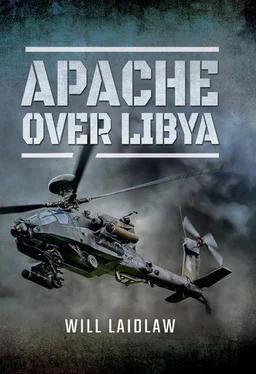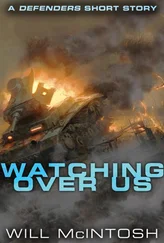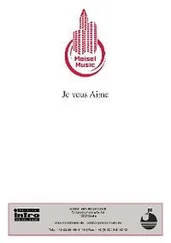Nick fast-forwarded the tape, describing his decision to move in close: ‘I wanted the standoff range to maintain surprise and use the jet to suggest areas of interest, but they saw nothing. I asked the jets if they could see any movement, any targets, but they came back with a negative. “Nothing seen down there,” was his phrase. We decided to take a look anyway.’
Okba airfield stood lonely and apparently empty, its parallel east-west runways unused in months and its aircraft apron on the north side completely bare. About 100m north of the runways stood the distinctive pentagonal compound with Hardened Aircraft Shelters (HASs) forming spokes from its hub. The HASs were out of use, destroyed by delayed-fused 2,000lb bombs from miles up right at the start of the campaign. Since then the airfield had had no air utility and the place had been left to get hot and gather sand. But pro-Gad was using it to store equipment and rest soldiers prior to sending them south to the Nafusa Mountains. It was their safe place to make plans, gather weapons and set off to attack the FLF and civilians in the mountains.
‘See those five HASs.’ Nick pointed at the screen. ‘There’s a heat source in a second…’
And gradually I could see an emerging heat spot glowing white against cooler black temperatures and moving across the ground to the west of the pentagon. I wanted to see more, and as if anticipating this the FLIR zoomed in closer to identify the mover. The white-hot glow grew and took shape: a man, hunched over, carried something long and heavy across both arms. He moved quickly in a straight line and stopped suddenly in the open where a mark on the ground, about 10m long and a metre wide, crossed his path. Then it was as if he was enveloped into the mark – his body appeared to be swallowed and only his head remained visible.
‘Trench system,’ said Nick. ‘Look here and here, there’s loads of them.’ He pointed out similar marks around the airfield on Jay and Big Shipper’s guntape. ‘They’ve run out from the buildings and positioned themselves in trenches, and that is probably a MANPAD he’s just dropped off. They must have heard the commotion to the south-west. I reckon they were getting ready to defend the airfield.’
With the preceding target just five miles away, the sound of the Hellfire and 30mm ripping up eight technicals would have carried easily in the desert night. Any pro-Gad in Okba would be ready and waiting, expecting the Apache to visit. The movement on the ground looked like classic pre-launch anti-helicopter work. Zlitan twice, and the Brega mission, had told us that much.
Nick sent in a Hellfire and instantly changed the picture. Then 30mm followed up the Hellfire and the manned trench ceased to be a threat.
As Underdog One broke away to the left Jay and Big Shippers, who had been searching for targets in the same area, were cleared in to the attack.
Jay destroyed a pair of warm-engined military trucks near the trench system and, shifting his sights further north still by another 100m, settled on a communications node with its satellite dishes and antennas pointing north-east towards Tripoli. With one Hellfire and now low on ammunition, he switched to the minimum 10-round, one-second bursts and added 60 rounds of 30mm in a 30-second onslaught that cut Okba off from the rest of Libya. Now it was isolated, and on fire. The place where from where the regime thought it could mount attacks into the mountains was broken and in disarray.
The inter-aircraft radios were cackling with information about target coordinates, pro-Gad runners, weapons systems being moved and vehicles moving and hiding. But it had already been a long mission, ammunition was running out and both aircraft were low on fuel for the long, hostile transit back to the coast and beyond.
Between the two aircraft they picked off four more vehicles, sending pro-Gad once again racing into the desert, useless without his weapons. With just two laser-guided Hellfire and sixty 30mm left, Jay and Big Shippers noticed their fuel was now at ‘bingo’ – the minimum quantity left to allow a safe return to Ocean . It was time to leave, and Nick made the decision to do so. With targets racing around the airfield it seemed ridiculous, but the point had been made and jet man had better things to do over Tripoli; so, cursing the fact that he had just two Apaches in his patrol, Nick directed Charlie and Big Shippers to turn north and begin the low-level transit back to Mother.
Nick and Charlie took the lead, but Charlie was off form, he couldn’t keep it straight and level, the aircraft was off heading, its height constantly changing. Being very low-level, this nibbled precariously at the margins for error.
‘Sorry, Nick, HMD on the blink. Keeps dropping out. Everything is wonky. Static in the eye, no feeds, symbology off, using the NVG on the left to keep us somewhere decent.’
Charlie was dealing with a Helmet Mounted Display failure. The information being projected into his right eye was intermittent and more of a distraction than an aid to low-level combat flying. In a low threat environment the aircraft could have climbed away from the ground to a safer height and allowed the crew time to rectify the fault. Not here. Not 50 miles inland behind regime lines. They had to stay low and accept that they were down to one set of eyes.
‘Okay, got it, I have control.’ Nick took the flight controls while Charlie tried to wrestle the technology and set himself up to fly the return leg.
Meanwhile, Nick transmitted to Jay and Big Shippers, ‘Heading zero-one-zero, your lead, we’re lame duck, HMD failure in rear seat, call passing.’
Big Shippers was straight on the net: ‘My lead, passing left-hand side 30 seconds heading zero-one-zero.’
He and Jay now took control of the patrol as it entered its most vulnerable stage. The transit back to the coast was over new ground, 60 nautical miles of it, all pro-Gad. During planning, the satellite imagery looked clear of habitation, and their chosen crossing point to the Med was only a few miles away from the Tunisian border. The patrol had kept to their fuel calculations and they had just enough to get across the desert and then coast out to find Ocean . Both aircraft knew they were in the final and uniquely exposed phase of the mission: low on fuel, very low on ammunition, a long time inland and with pro-Gad waiting for them to come back north and cross the coast. If the regime was going to stop an Apache, this was their chance. Tonight the added complication was that only one Apache was fully operational, and it was providing both navigation and defence for both.
In Underdog One Nick was flying, hands on the control, as well as searching for threats, while tracking Jay and Big Shippers, who were able to search and navigate while taking the lead.
They raced at 120 knots low-level across the barren emptiness, scanning all the while. With ten miles to run until the heightened anxiety of crossing the coast, Jay picked up a heat-spot on his FLIR hidden amongst some trees – probably a life-saving observation.
He notified Big Shippers: ‘Technical, right 2 o’clock, 2 kilometres. Group of trees. Technical in the centre. Weapons on the rear, dismounts seen. Actioning missile!’
In the rear seat the master of Apache gunnery glanced in at his right-hand MPD displaying Jay’s FLIR video image and directed Jay: ‘Coming right. It’s too close to fence around. Underdog One is vulnerable. Coming into constraints, you have one shot. Closing fast… good Lock-On Before Launch, missile will come off the left rail… ready.’
Big Shippers had expertly aligned the aircraft to give Jay direct line of sight through the trees at low height. Three pro-Gad soldiers were hiding, attempting to keep a tree between them and the aircraft, but they weren’t the target. The threat was on the back of the technical; a large weapon system, possibly a MANPAD, was mounted on its rear.
Читать дальше












